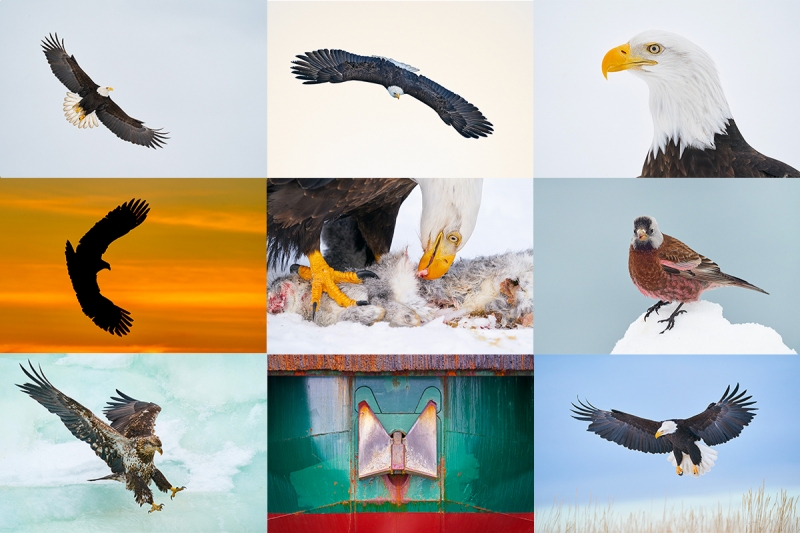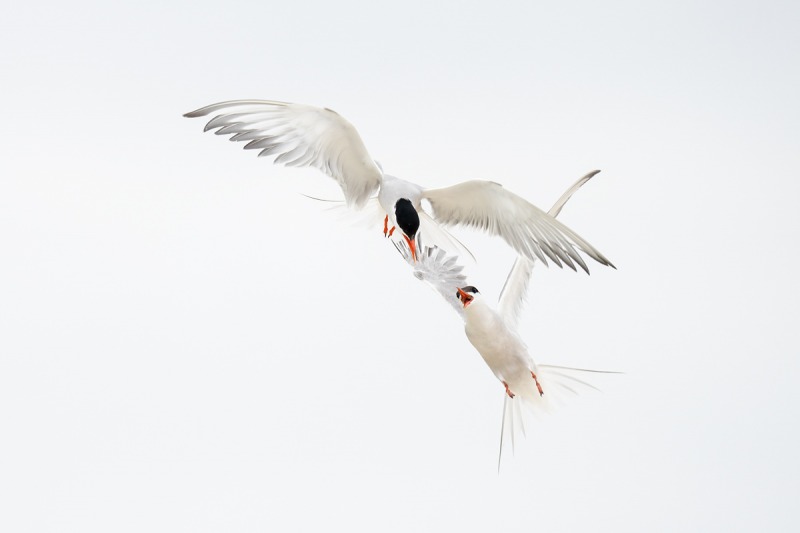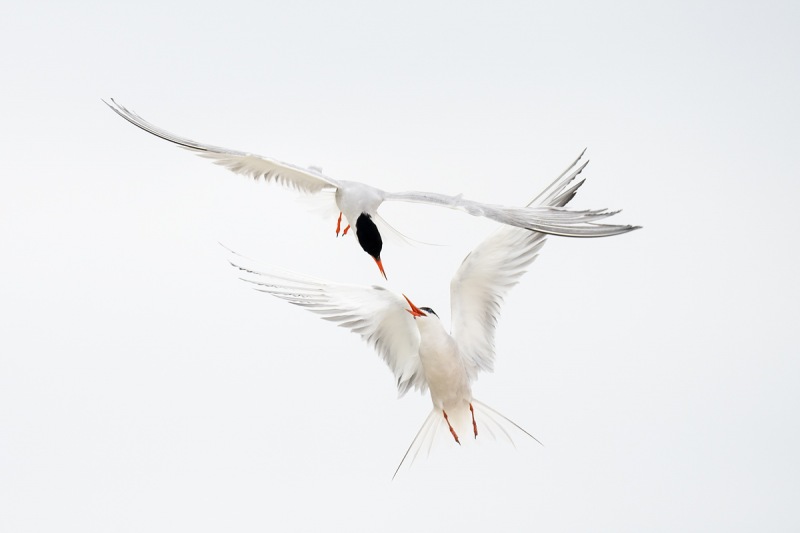Your Call?
According to you, which is the stronger image (by far)? Why?
What’s Up?
For the first time ever, I spent 13 hours at the beach. With the delayed entry time at Nickerson Beach, I had been thinking about staying all day to avoid having to re-enter at 6pm. So when private In-the-Field client Anke Frohlich suggested that we do just that, we did. With perfect cloudy/fairly bright conditions and a northwest wind, we enjoyed an incredible session (by being in the exact right spot …) We photographed until 12:15 before heading for a picnic lunch. The afternoon was far more challenging as the sun came out and the wind switched to the southeast. Not good. Our best chances were with skimmers battling in midair. With some decent sunset color late in the day, we opted to try for some sunset silhouettes. The wind switched to the southwest. Again, not good.
I created 3357 images; I will be picking my keepers after I hit Publish. When we took a peek at my morning folder during Image Review, we came across today’s featured images. To make sure that I did not accidentally screw up and delete them, I tagged them in Photo Mechanic and placed them in a TEMP sub-folder. I am not yet positive that one of them will be my very favorite image from a great day, but that is likely. Finding one that I like better would be a huge thrill.
With another sign-up and lots of interested folks, the 2022 Homer/Kachemak Bay Bald Eagle IPTs are looking good. Each trip needs four to run. I am still hoping to find a roommate who signs up for all 11 days. I was glad to learn of the sale of Ron Horn’s Canon EOS-1DX Mark II.
Today is Friday 6 August 2021. With clear skies and a west wind, staying in this morning was the obvious choice. Wherever you are, and whatever you are doing, I hope that you too have a great day.
Remember that you can find some great photo accessories (and necessities!) on Amazon by clicking on the Stuff tab on the orange/yellow menu bar above. On a related note, it would be extremely helpful if blog-folks like me, who spend too much money on Amazon, would get in the habit of clicking on the Amazon logo link on the right side of each blog post when they shop online. As you might expect, doing so will not cost you a single penny, but would be appreciated tremendously by yours truly. And doing so works seamlessly with your Amazon Prime account.
This blog post took a bit more than an hour to prepare, and makes 221 consecutive days with a new one. Please remember that if an item — a Delkin flash card, or a tripod head — for example, that is available from B&H and/or Bedfords, and is also available in the BAA Online Store, it would be great, and greatly appreciated if you would opt to purchase from us. We will match any price. Please remember also to use my B&H affiliate links or to save 3% at Bedfords by using the BIRDSASART discount code at checkout. Doing either often earns you free guides and/or discounts. And doing so always earns my great appreciation.
|
|
|
Click on the composite to view a larger version. Homer 2020 IPT Images |
Homer Bald Eagles Winter 2022
The photography on this trip of a lifetime is beyond amazing. You can do the whole trip with either the Canon 100-500 or the SONY 200-600 along with any 70-200mm lens. Flight photography until you cannot raise your arms, creative set-ups, lots of snow we hope (earlier in the season is best for that), and lots of opportunities for point-blank head portraits and talon shots. All in a variety of spectacular settings. This is an expensive (but competitively priced) trip. If you are seriously interested in joining me for the world’s best Homer/Kachemak Bay Bald Eagle trip(s) — mid-FEB thru early MARCH 2022, please contact me immediately via e-mail for dates and details. I am looking for a roommate who will be doing all eleven days.
|
|
|
This image was created on 5 August 2021 at Nickerson Beach. While standing at full height, I used the Induro GIT304L Grand Series 3 Stealth Carbon Fiber Tripod/Levered-Clamp FlexShooter Pro-mounted-Sony FE 600mm f/4 GM OSS lens and The One, the Sony Alpha 1 Mirrorless digital camera. ISO 800. Exposure determined via Zebras with ISO on the rear dial: 1/3200 sec. at f/4 (wide open). RawDigger showed that the raw file was almost perfect, about 1/6 stop under-exposed. AWB at 11:33:40am on a cloudy morning. Tracking: Center Zone/AF-C resulted in a sharp image. As Image #1 is a substantial crop, it was the distance to the subject that provided sufficient depth of field. At a given aperture, in this case f/4, the greater the distance to the subject, the greater the depth of field. Be sure to click on the image to enjoy the larger version. Image #1: Common Terns battling in midair |
Loving White Sky Days
These images were created after 11:30am. If it had been a clear sunny day, I would have quit hours before regardless of the wind direction. The soft light on cloudy-bright days allow you to photograph in any direction — staying on “sun” angle becomes a moot point. In such conditions, you will not get the dark shadows on the bird that plague flight images made on clear, blue-sky days and decent wing positions will reveal superb underwing detail.
To drive home my point, here is more of the same from yesterday’s blog post:
I chuckle also when I think of my first decade of photography; I would not head out to do photography unless it was sunny. Such were the limitations of Velvia 50 push processed one stop to ISO 100. Cloudy-bright days are ideal as there is enough light to work at reasonable ISOs with decent shutter speeds and no shadows at all. And best of all, the “wrong” wind direction is never a problem when you are photographing when the world is a soft-box.
|
|
|
This image was created on 5 August 2021 at Nickerson Beach. While standing at full height, I used the Induro GIT304L Grand Series 3 Stealth Carbon Fiber Tripod/Levered-Clamp FlexShooter Pro-mounted-Sony FE 600mm f/4 GM OSS lens and The One, the Sony Alpha 1 Mirrorless digital camera. ISO 800. Exposure determined via Zebras with ISO on the rear dial: 1/3200 sec. at f/4 (wide open). RawDigger showed that the raw file was almost perfect, about 1/6 stop under-exposed. AWB at 11:33:40am on a cloudy morning. Tracking: Center Zone/AF-C resulted in a sharp image. As Image #2 is a substantial crop, it was the distance to the subject that provided sufficient depth of field. At a given aperture, in this case f/4, the greater the distance to the subject, the greater the depth of field. Be sure to click on the image to enjoy the larger version. Image #2: Common Terns battling in midair |
The Realities of 30 Frames per Second
With your a1 set up properly, you will be able to take full advantage of 30 frames per second. Please do not be misled into thinking that you will capture every possible moment (or pose). Let’s divide one second into 4000 tiny increments. There will be 4000 different poses in one second. So when you are working 30 fps with a shutter speed of 1/4000 second, you will capture 30 of those moments. Thus, you are missing 3970 of those moments. That means that you will be missing 99.25% of the poses.
The good news is that when working at 30 fps, you will get to pick from 50% more “moments” than when working at 20 fps, and three times as many moments (or poses or frames) than you would if you had been working with a 10 fps camera body.
How Fast is a Blink?
Today’s two featured images were created consecutively in a short burst in the same second. They represent two of the thirty moments (or poses or frames) captured in that same second. Though it is difficult to see in the 1200 pixel wide JPEGs here, the bird’s nictitating membrane is covering the eye in Image #2, but the eye is fully open in Image #1. Aside from giving us 30 moments (or poses or frames) every second, we get some excellent insurance protecting against nictitating membranes. This can become very important when shooting larger-in-the-frame portraits of static subjects.
SONY and artie
Switching to SONY, first with the a9 and the a9 II, and then with the remarkable a1, has enabled me (and others, like Mike De Rosa as seen recently in the blog post here), to create images of birds in flight and in action that I could not have even dreamed of when using Canon for 33 years and then Nikon for more than two. Most of the time I am using one of two AF methods that together, cover about 99% of the commonly-encountered bird photography situations. At present, I am experimenting beyond those … Learn more by joining the group!
From Long-ago IPT veteran Keith Kennedy via e-mail
Absolutely great information. I am calling Jim in a few minutes to order a couple of Delkin 128GB UHS-II cards. Your timely email has saved me a ton of money! Many thanks
In the same vein, via e-mail from John LeClair
Well, e-mail #21 alone was worth the price of admission!
From Pamela Viale, after receiving artie’s a1 settings along with detailed instructions on how to copy them to her SONY a1 via e-mail
This e-mail group has been an incredible boon to me! Thank you so much!
From Joe Barranco via e-Mail
Thanks for your great ideas on the A1 set up. I have been getting MANY more keepers doing things your way!
From Barbara White via e-Mail
Wow, I just gotta say – I learn so much from the SONY Alpha a1 Set-up and Info group! My camera is on my desk, and I’m always picking it up and changing something that I’ve read about in the e-mails.
Thanks, Barbara
From Janet Horton via e-Mail
Hi Artie, Mystery solved. Yes, I was able to replicate what you did. I forgot that you have to set self-timer using the upper dial. I am used to that being a MENU selection.
Thanks much, Janet
SONY Alpha a1 Set-up and Info Group
The SONY Alpha a1 Set-up and Info Group is going great guns as more and more folks chime in with thoughtful questions and experience-based answers. As the a1 is becoming more readily available, more and more folks are getting their hands on this amazing body. With two folks joining yesterday, we are now up to an astounding 67 lucky and blessed photographers! Early on, we discussed the myriad AF options. I gave my opinion as to the best one for flight and general bird photography. More recently, we have been in contact with folks at SONY sharing our thoughts, experiences, and frustrations with the EVF blackout problem.
All who purchased their Alpha a1 bodies via a BAA affiliate link will receive a free subscription to the Sony Alpha a1 Set-Up and Info Updates after shooting me their receipts via e-mail. (Note: it may take me several days to confirm B&H orders.) This same service may be purchased by anyone with an a1 body via a $150.00 PayPal sent to birdsasart@verizon.net indicating payment for Alpha a1 Info Updates. Alternatively, folks can call Jim weekdays at 1-863-692-0906 to pay via credit card. New members will receive composite e-mails that summarize all previous discussions.
Typos
With all blog posts, feel free to e-mail or to leave a comment regarding any typos or errors.

















Both are great, but #2 is angelic.
The down side of 20 frames per second on my R5 is that I end up with so many files it makes reviewing them a real chore. I was photographing an immature red shoulder this morning about 20 yards away. It was preening for quite a while. Got some nice shots of it calling. Had it on 20fps because I was waiting for it to take wing. Someone called to me and I looked back. Bird took off and I missed it. Oh well. Have hundreds of frames of the still bird and I can’t stand to look through them all. Will throw them on the hard drive and save them for a snowey day (I’m in Florida). On the flip side, I got 20fps of great egret taking off and flying low for a while, properly exposed for a change. 4-5 are very nice and will be hard to choose. I can’t imagine dealing with 30fps.
I like #2 better. Very Nice!
Mike
You need to learn to edit in Photo Mechanic. A 3000 image folder takes me ten minutes to get through … I will be releasing a picking your keepers video soon.
with love, artie
As art, I like Image 2, despite the nictitating membrane, which isn’t really noticeable here, but seems fixable. The interaction lacks the violence of Image 1, looks more like dancing cranes or a Japanese painting. For action, if the upper bird in Image 1 actually has hold of the wing of the lower bird (again, hard to see at this size), then maybe Image 1 is superior.
Didn’t the cover of the hardback The Art of Bird Photography have a nictitating membrane?
Image 2 for me. Less overlap of the birds leads to more focus on the interaction.
Camera systems seem to leap-frog each other. I remember what you said when you first got the Canon 1dx @ 12 frames per second. You said you were getting shots you never thought were possible. But, let’s not give too much credit to the camera :). It takes the best shooter to get the best shots.
The second one for me….capturing the split second just before contact is dynamic.
I like the 2nd shot best. I think it’s a cleaner composition and better interaction between birds.